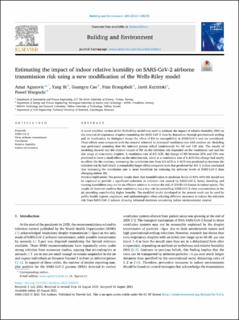| dc.contributor.author | Aganovic, Amar | |
| dc.contributor.author | Bi, Yang | |
| dc.contributor.author | Cao, Guangyu | |
| dc.contributor.author | Drangsholt, Finn | |
| dc.contributor.author | Kurnitski, Jarek | |
| dc.contributor.author | Wargocki, Pawel | |
| dc.date.accessioned | 2021-10-14T08:40:13Z | |
| dc.date.available | 2021-10-14T08:40:13Z | |
| dc.date.created | 2021-09-13T09:15:30Z | |
| dc.date.issued | 2021 | |
| dc.identifier.citation | Building and Environment. 2021, 205 1-14. | en_US |
| dc.identifier.issn | 0360-1323 | |
| dc.identifier.uri | https://hdl.handle.net/11250/2812229 | |
| dc.description.abstract | A novel modified version of the Wells-Riley model was used to estimate the impact of relative humidity (RH) on the removal of respiratory droplets containing the SARS-CoV-2 virus by deposition through gravitational settling and its inactivation by biological decay; the effect of RH on susceptibility to SARS-CoV-2 was not considered. These effects were compared with the removal achieved by increased ventilation rate with outdoor air. Modeling was performed assuming that the infected person talked continuously for 60 and 120 min. The results of modeling showed that the relative impact of RH on the infection risk depended on the ventilation rate and the size range of virus-laden droplets. A ventilation rate of 0.5 ACH, the change of RH between 20% and 53% was predicted to have a small effect on the infection risk, while at a ventilation rate of 6 ACH this change had nearly no effect. On the contrary, increasing the ventilation rate from 0.5 ACH to 6 ACH was predicted to decrease the infection risk by half which is remarkably larger effect compared with that predicted for RH. It is thus concluded that increasing the ventilation rate is more beneficial for reducing the airborne levels of SARS-CoV-2 than changing indoor RH. | en_US |
| dc.language.iso | eng | en_US |
| dc.publisher | Elsevier | en_US |
| dc.rights | Navngivelse 4.0 Internasjonal | * |
| dc.rights.uri | http://creativecommons.org/licenses/by/4.0/deed.no | * |
| dc.title | Estimating the impact of indoor relative humidity on SARS-CoV-2 airborne transmission risk using a new modification of the Wells-Riley model | en_US |
| dc.type | Peer reviewed | en_US |
| dc.type | Journal article | en_US |
| dc.description.version | publishedVersion | en_US |
| dc.source.pagenumber | 1-14 | en_US |
| dc.source.volume | 205 | en_US |
| dc.source.journal | Building and Environment | en_US |
| dc.identifier.doi | 10.1016/j.buildenv.2021.108278 | |
| dc.identifier.cristin | 1933583 | |
| cristin.ispublished | true | |
| cristin.fulltext | original | |
| cristin.qualitycode | 2 | |

